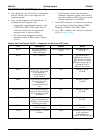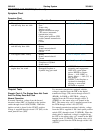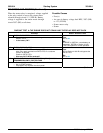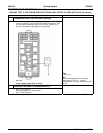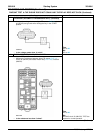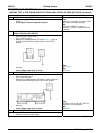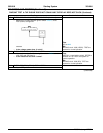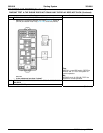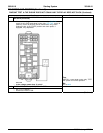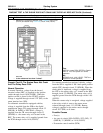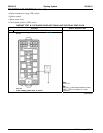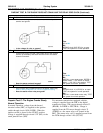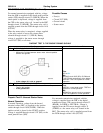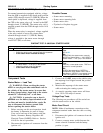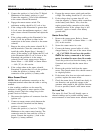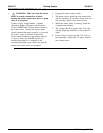
303-06-16 303-06-16Starting System
DIAGNOSIS AND TESTING (Continued)
3. Connect the positive (+) lead of the 73 Digital 4. Engage the remote starter switch and read the
Multimeter to the battery positive (+) post. voltage. The reading should be 0.2 volt or less.
Connect the negative (-) lead of the multimeter
5. If the voltage drop is greater than 0.2 volt,
to the starter solenoid M-terminal.
clean the negative (-) battery cable connections
4. Engage the remote starter switch. The at the battery and chassis. Also, clean the
multimeter reading should be 0.5 volt or less. engine ground cable connection at the cable
mounting bracket. If the voltage drop is still
5. If the voltage at the M-terminal is greater than
excessive, repair or install a new battery
0.5 volt, move the multimeter negative (-) lead
ground cable.
to the starter solenoid B-terminal and repeat the
test.
Starter Drive Test
6. If the voltage reading at the B-terminal is less
1. Remove the starter motor. Refer to Starter
than 0.5 volt, the problem is either in the
Motor — 4.0L SOHC or Starter Motor — 4.6L
connections at the starter solenoid or the starter
(3V) in this section.
solenoid.
2. Secure the starter motor in a vise.
7. Remove the wires at the starter solenoid B-, S-
3. Connect the battery ground cable of a fully
and M-terminals. Clean the connections and
charged battery to the case of the starter motor.
install the cables. Repeat Steps 1 through 5
above. If the reading is still higher than 0.5 volt
4. CAUTION: Do not leave the positive
at the M-terminal and 0.5 volt or lower at the
lead of the battery connected to the starter
B-terminal, the problem is in the starter
motor S-terminal for more than 10 seconds.
solenoid. Install a new starter motor. Refer to
Touch the positive lead from the battery to the
Starter Motor — 4.0L SOHC or Starter Motor
S-terminal and verify that the starter drive
— 4.6L (3V) in this section.
ejects.
8. If the voltage taken at the starter solenoid
5. Remove the positive lead from the starter
B-terminal is greater than 0.5 volt, the problem
motor. The ejected starter drive should return to
is either the positive (+) battery cable
its original position.
connection or the positive (+) battery cable.
6. If the starter drive does not eject and return to
Motor Ground Circuit
position, replace the starter motor.
NOTE: Make all multimeter connections at the
7. Check the starter drive. It should turn freely in
component terminal rather than the cable or wiring
one direction, and positively engage to the
terminal.
armature when turned in the opposite direction.
If not as specified, install a new starter motor.
A slow cranking condition can be caused by
resistance in the ground or return portion of the
No Load Test
cranking circuit. Check the voltage drop in the
The starter No Load Test will identify open or
ground circuit as follows:
shorted windings and a possible rubbing starter
1. Disconnect the ignition coil connector from the
motor armature or bent starter motor armature shaft.
ignition coil.
2. Connect a remote starter switch between the
starter solenoid S-terminal and the battery
positive (+) terminal.
3. Connect the positive (+) lead of a 73 Digital
Multimeter to the starter motor housing. The
connection must be clean and free of rust or
grease. Connect the negative (-) lead to the
negative (-) battery terminal.
2005 Mustang, 12/2004



